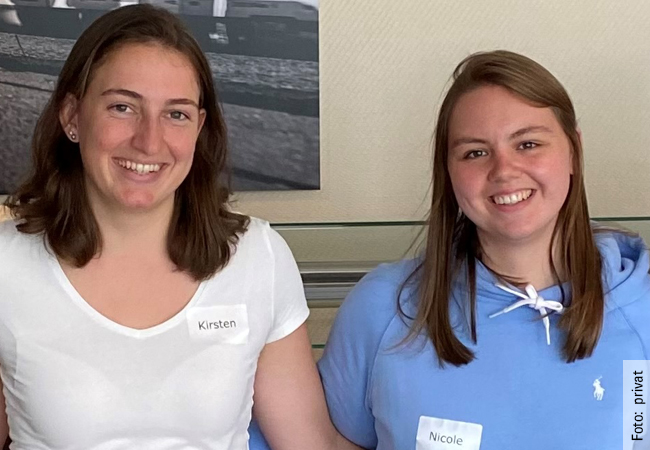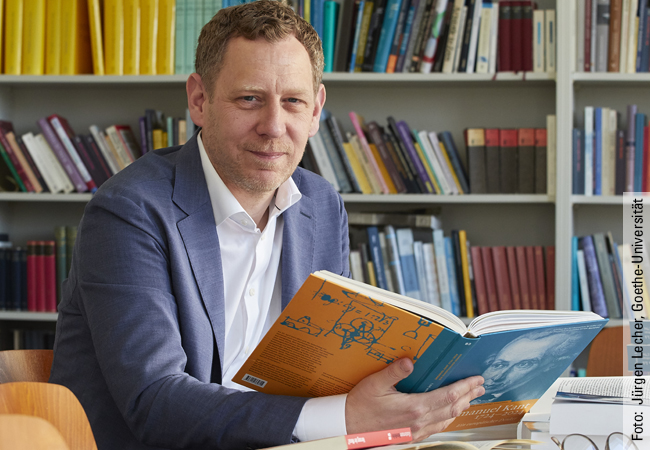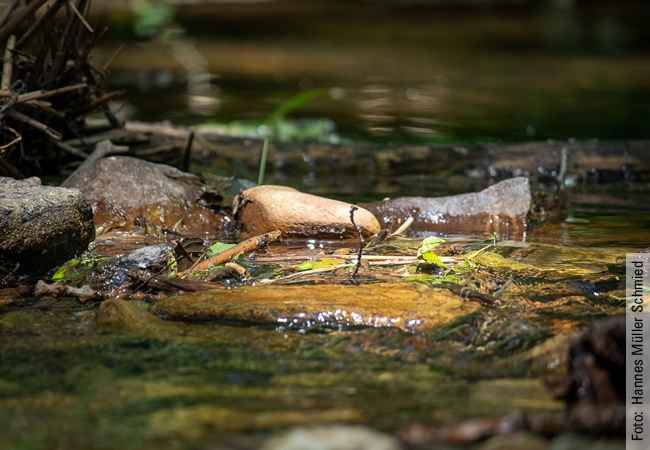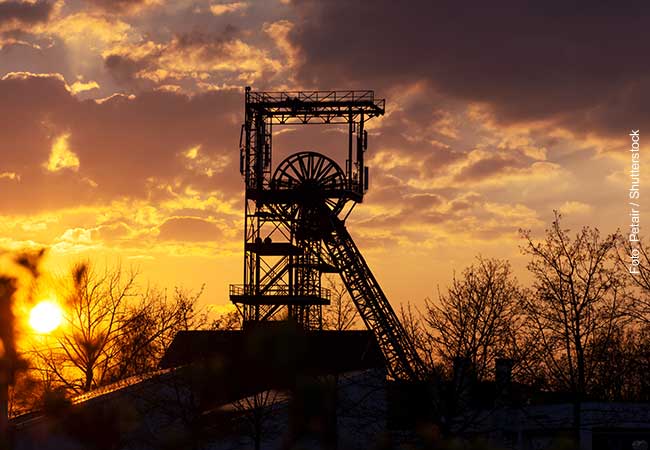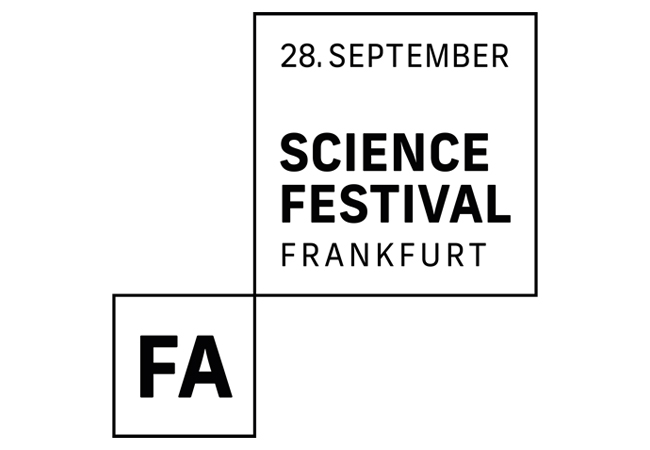Landscape architect Robert Anton has been responsible for the flora and fauna on Goethe University’s grounds for the past eleven years, and during his tenure has seen ecological aspects become increasingly important. We met him on Westend Campus to discuss all matters related to sustainability.
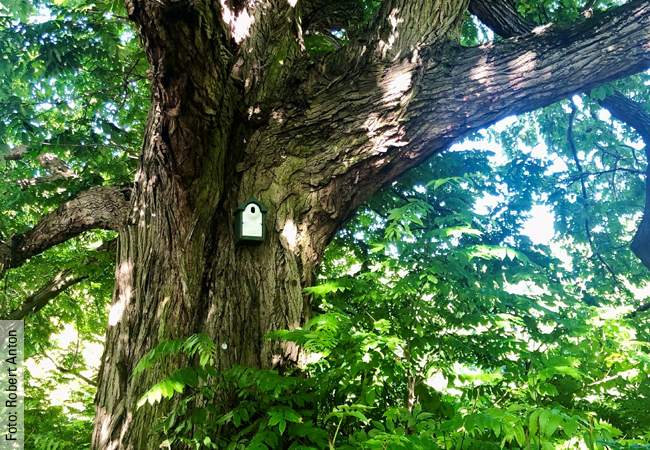
UniReport: Anyone talking to you quickly gets the impression that sustainability can be a cause of joy. You have what seems to be an endless amount of ideas…
Robert Anton: I’ve always enjoyed gardening. It started at age five, in my parents’ garden, continued through elementary school, and has stayed with me since. To me, sustainability stands at the heart of any gardener. When I started out, the word as such didn’t yet exist. To be honest, I find its contemporary over-usage to be slightly irritating. But as a landscape architect I consider it my job to put sustainability into practice, including by means of simple acts like installing a birdbox – which is also a way of implementing sustainability, since birds eat processionary moths and pests. I have to admit though that, over the years, my thought process has become increasingly ecological.
So nature conservation didn’t always feature in the training for landscape architects?
No, classical garden design used to be completely different. It mostly focused on orderly ornamental gardens with lawns, hedges and ornamental shrubs, partly influenced by the Renaissance gardens in Italy. That has changed a lot during the past few years. Nowadays, landscape architects design gardens that are a much closer resemblance of nature, and everyone talks about biodiversity. The topic of sustainability is gradually starting to enter people’s minds. They understand that not all meadows have to be mown right away and that in some areas plants should be left to grow wild. It’s about giving something back to nature.
How are the topics of climate change and loss of biodiversity reflected on campus? Has your work evolved over the years?
It certainly has. Today we can grow plants in Frankfurt that wouldn’t have survived here thirty or forty years ago. The climate has changed dramatically, and it has become much, much milder. Just look at the windmill palms in the Palmengarten botanical gardens – transported by wind and animals, their seeds have spread throughout Frankfurt, and are no longer killed off by freezing weather.
My main inspiration for thinking more sustainably has been the “Science Garden” with its many natural areas and meadows. On Riedberg Campus, Professor Paul Dierkes has created a school garden that is a true nature garden. Dierkes has been researching biodiversity ever since this garden was first created. Today, 939 different species of animals and plants inhabit an area of nearly 2,000 square meters. Many of them are on Germany’s red lists of endangered species, and yet we suddenly see these animals appear and thrive in the habitat. So it’s important that we don’t work against, but instead cultivate in a manner that works with nature. That’s why I think it’s good that the “GemüseheldInnen” vegetable growers [https://gemueseheldinnen.de/] will get a patch on campus, and that permaculture gardeners will also receive one. There is, after all, plenty of space.
Do you also benefit from scientific findings?
Climate change is not new, but its effect have become clearly visible since around 2000. In summer, for example, the temperature in our greenhouses can reach up to 50 degrees. This means that we are no longer able to keep all plants alive simply by watering them. On Westend Campus, too, trees are dying, some of which I remove. I leave others in place, so the dead wood can rot. I then plant trees that hopefully will resist the future climate, by following an easy development logic: when it gets warmer, plants move from south to north. When it gets colder, they move in the opposite direction. The vegetation largely adapts on its own, but we also have to help it along.
One way scientists could help landscape gardeners would be to offer us tips so we plant trees that are more closely genetically related to our local flora and therefore also benefit local wildlife. The Chinese tree of heaven, for instance, grows very well here, but it’s absolutely useless to our fauna. Mediterranean oaks, on the other hand, are very similar to our oak trees; it’s almost impossible to tell some of them apart. Professor Wolfgang Brüggemann has been researching topics like these for at least 25 years. Of course, I also rely on research results when creating the “forest of the future” in the Science Garden. I planted four chestnut-leaved oaks, for instance, in front of the PA Building [housing the Executive Board’s offices] on Westend Campus. They’re great at resisting the heat reflected from the building in the afternoons.
You’re very active in greening roofs on campus. When it comes to facade greening…
…nothing’s happening at the moment. But we’ve done a lot of greening of roofs on Westend Campus, which we are right now allowing to grow naturally. We only intervene if plants or trees start blocking the drains or the waterproofing. There are, however, some things that we would do differently nowadays – for example, the roof of the Law and Economics Building was planted mostly with lavender. Today, we would add other plants as well…
As for facade greening – what can I say? There are some things architects tend not to want, including having their buildings greened. While I can understand that, I do wish we could in future also green buildings and that architects would adjust their way of thinking. After all, plants not only prevent buildings from heating up, they also provide habitats for birds and insects. There also exists special window glass with films that birds can see, which stops them striking the windows, as frequently happens in the Biology Building on Riedberg Campus. A very simple and effective measure would be to plan openings at the top of curtain facades; this could provide a large number of potential nesting sites for wall breeders like swifts, swallows and bats. Another example is the site where I planted the chestnut-leaved oaks. We used to have bird cherries there, which grow in moist alluvial woodlands…
…that never existed here…
…exactly. The suggestion came from someone in a planning office who had obviously never visited this site. While they are definitely beautiful trees, they can’t grow here. Beyond that, vegetation times have also changed. Both droughts and heavy rains are becoming more extreme, making life difficult for the plants.
What projects are you particularly proud of?
Actually, I’m proud of all the measures undertaken. What I really enjoy though is being involved in designing this landmarked campus and making it climate-resilient. That’s because I consider it my job to compensate for all the negative things happening right now by planting new trees, so the campus will be nice and green. So that it has a lot of flora. Beyond the buildings, it is after all the greening that hugely enhances its beauty…
The architects would probably protest now…
Well, a good architect always has a landscape architect at hand – the two go together. Alas, to some extent, that is part of the age-old disagreement between architects and landscape architects, which manifests itself in inner courtyards for instance. They have been planted with lots of shady plants; but when the summer sun stands high, they burn. These spots should feature other kinds of plants.
Besides sustainability, beauty is also a criterion for you, is it not?
Definitely. As such, I would like to make the Science Garden look more attractive, and have already changed some aspects by adding low walls that people can sit on. The scientists don’t necessarily need them, but do consider them attractive. Even people who are clueless about design are very quick to recognize such attractive aspects, which turn a garden into a space where people feel at home. Gardens shouldn’t excite people – they should be calming.
So to you Westend Campus is a large garden?
A large park.
Do you regularly walk across the campuses peering into all the corners?
I visit each campus every week, where I walk the grounds together with a colleague, reflecting on what problems occurred during the past week, what sort of trees we want to plant, what we’re going to do about the blue-winged grasshopper…
What about the blue-winged grasshopper?
The city once decreed that if a building was erected in a place where these grasshoppers lived, a habitat had to be created for them. We have such habitats, which we examined after a while to find out whether any grasshoppers were still living there. Turns out they are – and in large numbers. What’s more, we also found other species of grasshoppers. That’s when we decided to put out more gravel in the habitats, something grasshoppers need.
Do you have any ideas or favorite projects that you still want to realize?
I would like to carry on monitoring the trees to ensure we develop a good, strong arboreal stock. And I’d like more wildernesses – areas we don’t have to actively look after any more – much like the garden in front of the IG Farben Building, whose 30,000 square meters of meadows incidentally are Frankfurt’s largest front yard. To the east of them lies a wood of yew trees, some of which are nearly 100 years old. There are hardly any yews left in our forests – they were all felled – meaning we have one of the largest contiguous colonies of yew trees for miles, right here on Westend Campus. It’s dark and cool when you enter this wood – a truly special atmosphere.
All the same, the university is not an isolated island in the midst of Frankfurt. Are you also in touch with the city? Do you have joint initiatives?
Yes, I’m in constant contact with the city, including with those concerned with trees – after all, I have to apply to the city for permission to fell trees. According to city regulations, every tree felled must be replaced. In my case, I always replace trees with double the number of new ones. In recent years, I’ve planted around 120 trees, most of them on Westend and Riedberg Campus.
So we have you to thank for the environmental benefit of getting double the number of new trees?
Yes. I enjoy the great privilege of having the leeway to do this. On Westend Campus we are planning to put up a block hive, which my colleague Peter Paul created shortly before he passed away. At some stage, we will hang up this hollowed-out tree trunk in which wild bees can build their nests. In addition, we’re also planning a “tiny forest.” I could also imagine letting the area next to the Law and Economics Building go wild. It already holds “smooth oat meadows” that are mown only twice a year. In addition, I want to stop mowing around the Adorno Monument and just let the leaves stay on the ground, to develop a kind of forest vegetation. Given that we have trustful relations, I don’t spend a lot of time consulting on such projects. Apart from that, forest vegetation tends to be cheaper than other measures.
Is there more widespread acceptance today for such overgrown meadows?
Of course there are those who regard a species-rich meadow as messy. This is one reason why I continually get calls from people expressing both praise and criticism. For example from students asking why the lawns are not watered in summer. I explain to them that it would take two million liters of water a week to keep the lawn green. And then of course there are those callers who chase me about sustainability. By the way, I could also imagine greening the “Campusplatz” in front of the auditorium building on Westend Campus…
What might that look like?
We could plant three nice trees there that will grow large. Such trees would give the square in front of the auditorium building a totally different feeling – it would resemble a nicely decorated room. I’m thinking of planting trees with forest grasses under them, and then installing benches for people to sit on. The wind could blow through the trees and produce a nice rustling noise. It would make for an absolutely positive development for the square – which is also why I’m never going to abandon this idea.
Lilly Gothe, Katharina Forster (Sustainability Office) and Pia Barth (PR & Communication Office) asked the questions.




